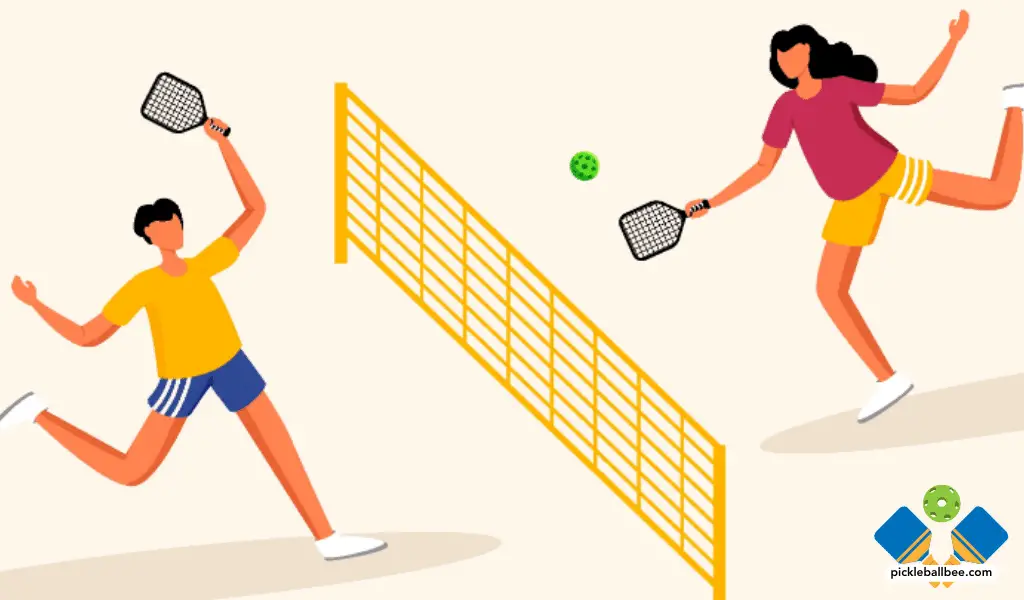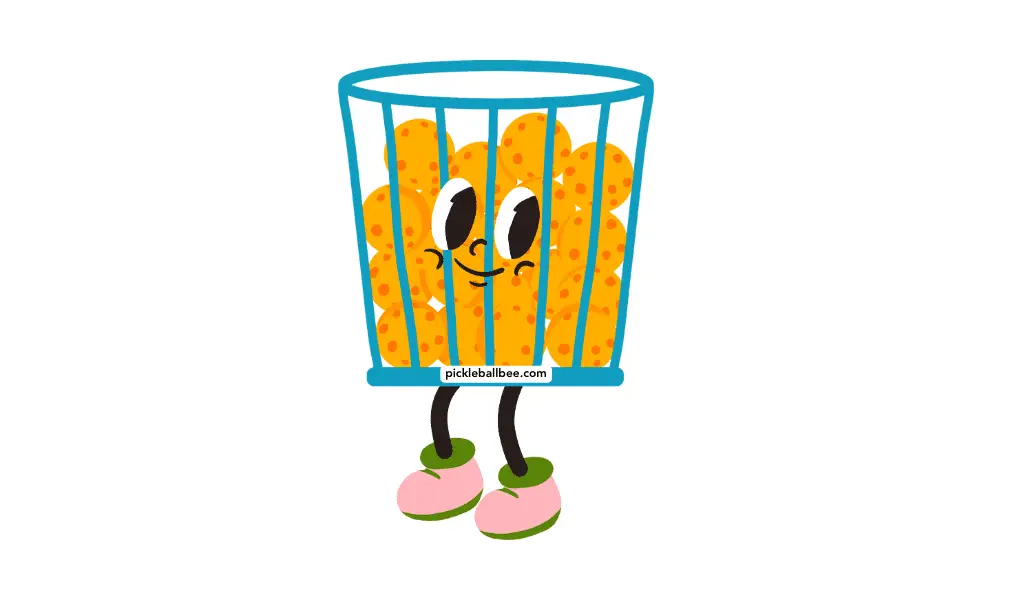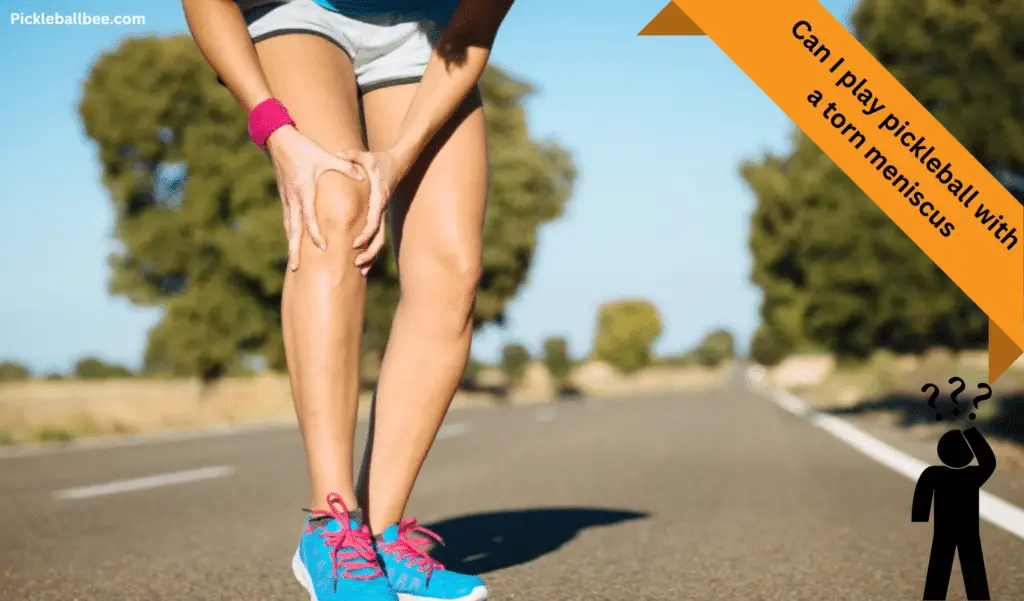Pickleball, the sport that’s taking the world by storm, is a captivating blend of tennis, badminton, and table tennis. Whether you’re a newcomer or a seasoned player, a fundamental question often arises: “What does a pickleball look like?” This comprehensive guide will delve into the exciting world of pickleball. We’ll explore the sport’s quirky name, break down its gameplay, and even provide insights into your needed equipment. By the end, you’ll have a crystal-clear picture of pickleball.

Table of Contents
Why Do They Call the Game Pickleball?
To truly grasp what a pickleball looks like, we must venture into the intriguing history of its name. The story behind “pickleball” is as unique as the sport itself.
In the mid-1960s, friends decided to invent a new backyard game on Bainbridge Island in Washington state. Joel Pritchard, Bill Bell, and Barney McCallum pooled their favourite sports elements to create something fresh and exhilarating. Legend said the game began with makeshift equipment, including ping pong paddles and a perforated plastic ball.
But why the name “pickleball”? One charming tale suggests it was named after the Pritchards’ dog, Pickles, who had a penchant for chasing stray balls during games. Thus, “pickleball” was coined, perfectly encapsulating the sport’s whimsical and spontaneous essence.
What Does a Pickleball Look Like?
Now, let’s address the fundamental question: What does a pickleball look like? The answer lies in the distinctive characteristics that set this sport apart.
A pickleball is a lightweight, perforated plastic ball adorned with evenly spaced holes across its surface. These holes contribute to an aerodynamic design, enabling the ball to traverse the air with precision and predictability. A standard pickleball is slightly smaller than a tennis ball, boasting a diameter of 2.87 inches (7.3 cm).
Pickleballs are available in various colours, with most being bright for optimal visibility during play. The choice of color often hinges on personal preference and prevailing playing conditions, with yellow and white being the most favored choices.
What truly distinguishes pickleballs is the unique sound they produce. When struck with a paddle, a pickleball emits a satisfying “pop,” adding an auditory dimension to the excitement of the game. This distinct auditory feedback has become integral to pickleball, enhancing the sport’s unique allure.
What Does a Pickleball Look Like to Play?
Now that we’ve unraveled the mystery behind the name let’s dive into the heart of pickleball – playing the game itself.
Imagine a rectangular, slightly smaller than a tennis court, with a net proudly standing at the centre. The net’s height, at 34 inches at the centre, mirrors a tennis net but is somewhat shorter at the sides. This court is divided into two halves by the net, thereby creating two non-volley zones near the net on each side.
Here’s where the magic happens: two, three, or four players stand poised with paddles, ready to embark on a fast-paced rally. The objective? Score points by skillfully sending a pickleball over the net and into the opponent’s court, rendering it challenging for them to return the ball.
Each point initiates with a serve, where players must hit the ball diagonally across the net. The non-volley zone, often dubbed the “kitchen,” introduces a strategic element. Players can only volley the ball while standing in this zone if the ball bounces first.
Pickleball is renowned for its quick reflexes, skill, and agility requirements. The ball moves with surprising speed, necessitating players to excel in offence and defence. It’s a sport that marries finesse with power, promising an electrifying challenge every time.
How hard is it to learn pickleball?
Pickleball is relatively easy to learn, especially for those familiar with racket sports. Its straightforward rules and smaller court size make it accessible to beginners.
Players can quickly grasp the basics with consistent practice and enjoy the game. Like any sport, mastering pickleball requires dedication and time.
What You’ll Need to Play Pickleball
To embark on your pickleball adventure, you’ll need the appropriate gear. Let’s break down the essentials:
Paddles:
Pickleball paddles are rectangular and flat, reminiscent of table tennis paddles but larger. They come in various materials, such as wood, composite, and graphite. The choice of material impacts the paddle’s weight and performance. Beginners often favour lighter paddles for better control, while more seasoned players may lean towards heavier ones for added power.
Balls:
The pickleball itself is a unique specimen. It resembles a whiffle ball, boasting evenly spaced holes. These perforations grant the ball its characteristic flight pattern and bounce. Pickleballs are often made of solid plastic to endure the rigors of the game.
Net:
The pickleball net, set at 34 inches centrally and 36 inches at the posts, delineates the court and maintains play standards. Crafted from durable materials, it stands resilient to regular use and weather. Its design aids strategy, challenging players to navigate their shots skillfully.
Footwear:
Suitable footwear is pivotal in pickleball due to its swift lateral movements. Athletic shoes with non-marking soles provide the necessary support and grip to navigate the court safely.
Optional Accessories:
While not mandatory, some players opt for extra accessories like pickleball-specific clothing, sweatbands, and protective eyewear. These items can enhance comfort and safety during play.
When selecting your equipment, consider your skill level and playing style. You may upgrade your gear to align with your evolving needs as you progress.
The Pickleball Paddle

The pickleball paddle is integral to the game and uniquely crafted for the sport’s demands. At its heart is the core, often made from materials like polymer, aluminium, or Nomex, each offering a distinct balance between power and control. The face, usually made of graphite or composite, directly affects how a player interacts with the ball regarding touch, spin, and power. Wrapping around its edges, an edge guard protects the paddle, though some players opt for edgeless designs to benefit from a more prominent sweet spot.
Comparing core materials, the polymer core is widely preferred for its soft touch and control, while the aluminium core is cherished for its lightweight nature and tactile ball feel. With its distinctive honeycomb pattern, the Nomex core is renowned for power but tends to produce more noise during play.
In terms of cost, pickleball paddles display a broad price spectrum. Basic beginner models might set you back just $20, while professional-grade variants can exceed $150. Brand reputation, material quality, and specialized features largely dictate these prices. For newcomers, it’s often recommended to begin with a more affordable paddle, upgrading as skills and passion for the game flourish.
If you want the best Pickleball Paddles, Check out this :
Pickleball Ball

Pickleball balls are distinct from those used in other racket sports and are designed specifically for pickleball play.
A pickleball ball is characterized by its round shape, perforated with numerous holes, which affect its flight and bounce. The structure of these balls is typically made from durable plastic material, ensuring they can withstand repeated play on various court types. There are two primary types: indoor and outdoor balls. Indoor balls have larger holes and are softer, suitable for smoother indoor surfaces. In contrast, outdoor balls have smaller holes, are harder, and can endure the rougher texture of outdoor courts.
Comparing the two, outdoor balls, because of their hardness, tend to have a faster and more predictable trajectory, which is advantageous in windy conditions. On the other hand, indoor balls, with their softer feel and larger holes, offer a different style of play, requiring players to adapt their strategy and technique.
When considering the price, pickleball balls are generally affordable. They’re often sold in packs, and prices can range from $8 to $20 for a pack of six, depending on the brand and type. Premium or tournament-grade balls might be slightly higher, but the sport generally ensures accessibility for all players through reasonable equipment costs.
If you want the best Pickleball Ball, Check out this :
Pickleball Net

The pickleball net is a fundamental piece of equipment that divides the court and plays a vital role in the game.
The standard pickleball net has a width of 22 feet and is typically set at 36 inches at the sideline posts, dropping slightly to 34 inches at the centre. The net is often crafted from durable, weather-resistant materials for outdoor use. It’s strung to be taut across its width, with a mesh fine enough to prevent the ball from passing through.
The market is filled with pickleball nets of all different kinds and brands. While some are better suited for casual or recreational use, others are made especially for professional or tournament play. Portable nets are now available for those who want the freedom to put up a game wherever they go.
Price-wise, a basic, recreational pickleball net can start as low as $50. Mid-range nets, which might offer better durability and ease of setup, could range from $80 to $150. Premium or tournament-grade nets, designed for competitive play and often boasting superior materials and construction, can range from $150 to $250. The best choice often depends on the player’s needs, frequency of play, and budget.
If you want the best Pickleball Ball, Check out this :
Pickleball Footwear
Pickleball shoes typically have a non-marking rubber sole, ensuring they don’t leave any marks on indoor courts. The tread pattern is designed to grip pickleball court surfaces effectively, preventing unwanted slips. A reinforced toe area provides protection, given the frequent forward movements in the sport. The midsole offers cushioning and shock absorption, while the upper ensures breathability, support, and flexibility.
Various pickleball footwear is available, ranging from dedicated pickleball brands to adaptations of tennis or volleyball shoes. While all are designed for court sports, dedicated pickleball shoes might offer more specific benefits like enhanced toe durability or lateral support tailored for pickleball’s unique movement patterns.
Casual or novice pickleball sneakers cost $50–$70. Mid-range shoes cost $70 to $120 and combine performance and value. Professional shoes cost $120 to $200 or more due to their superior materials, comfort, and performance. The most excellent sports equipment depends on the player’s needs, frequency of play, and budget.
If you want the best Pickleball Ball, Check out this :
Guide to Gameplay, Strategy, and Technique:
Understanding the Basics:
Before diving into the specifics, let’s grasp the fundamentals of pickleball. It’s typically played as a doubles game, but singles is also an option. The court is 20 feet wide and 44 feet long, with a 34-inch-high net at the centre. Only the serving team scores points, and the first team to 11 points (with a two-point advantage) wins the game.
Serving in Pickleball:
Serving is a crucial aspect of pickleball. It begins behind the baseline, diagonally across from the receiving team. The server must serve the ball underhand, ensuring it clears the net and lands in the opponent’s service court. Learn about different serving techniques and the importance of consistency.
Volleying Like a Pro:
Volleying is a crucial skill that distinguishes pickleball from other racket sports. Find out how to approach the net, maintain the no-volley zone (the “kitchen”), and execute effective volleys. Discover strategies for intercepting the ball mid-air and controlling the game’s pace.
Scoring Simplified:
Pickleball uses rally scoring; meaning points can be scored by either team, whether serving or receiving. Understand how issues are achieved, the concept of side-outs, and the strategies for maintaining a solid position on the scoreboard.
Tips for Beginners:
A blend of skill, strategy, and fun. As you embark on this exciting journey, let’s explore the essentials to get you started.
1. Mastering the Dink Shot:
One of the most critical shots in pickleball is the dink shot, a soft and controlled shot played near the net. Learn the technique, grip, and placement to execute precise dinks that keep your opponents on their toes.
2. Positioning for Success:
Effective positioning on the court is crucial to victory. Discover where you should stand during different game phases, such as serving, receiving, and volleying. Uncover the secrets of the “third shot drop” and how it can turn the tide in your favour.
3. Crafting Your Winning Strategy:
Pickleball is as much about strategy as it is about technique. Explore basic strategies for beginners, including the importance of teamwork in doubles plays. Understand when to employ a “soft game” or a “hard game” and adapt your strategy based on your opponent’s style.
Ultimate Guide to Pickleball Etiquette
Pickleball is not just about skill and strategy; it’s also a sport that values sportsmanship and etiquette. In this comprehensive guide, we’ll explore the crucial aspects of pickleball etiquette, highlighting the significance of playing with respect and courtesy on the court.
The Importance of Sportsmanship
What is Sportsmanship in Pickleball:
Start by defining sportsmanship in pickleball. It’s about fair play, respect for opponents, and maintaining a positive attitude on and off the court. Explore how good sportsmanship contributes to a better pickleball experience.
Setting a Positive Example:
Discuss the role of experienced players in setting a positive example for beginners. Explain how their behaviour can influence the pickleball community’s culture and atmosphere.
Handling Wins and Losses:
Offer guidance on how to handle both victory and defeat gracefully. Discuss the etiquette of shaking hands or bumping paddles with opponents after a game.
Standard Courtesy Rules on the Court:
Pickleball etiquette hinges on respecting standard courtesy rules. Players must be considerate, starting with proper court entry and exit to avoid disruptions. Maintaining a quiet and focused atmosphere is vital, refraining from loud conversations. Honesty inline calls, favouring opponents, fosters fair play. Adhering to the no-volley zone or “kitchen” rule is crucial. These rules ensure a smoother, more enjoyable game and preserve sportsmanship in pickleball.
Promoting a Positive Pickleball Community:
Promoting inclusivity and respect in pickleball is crucial for fostering a welcoming atmosphere. This extends to players of all skill levels, ages, and backgrounds. Encouraging experienced players to mentor newcomers creates a sense of community while improving skills and etiquette. This collective effort enhances the overall pickleball experience, ensuring everyone feels valued and supported on the court.
Pickleball vs other sports:
Pickleball stands out among racquet sports due to its distinctive blend of characteristics, making it a standout choice in competitive and recreational play. Unlike tennis and badminton, pickleball features a compact court, reducing the demand for lateral movement. It shares some elements with platform tennis and racquetball regarding court size and net height but distinguishes itself with a unique paddle and perforated ball. Squash and paddle tennis may involve walls, but pickleball’s open-court setting provides a refreshing change.
In contrast to the high-intensity rallies of racquetball and the agility needed for squash, pickleball offers a balanced pace suitable for players of all ages and skill levels, similar to the appeal of table tennis (ping pong). Its social and community-focused atmosphere also echoes the camaraderie seen in fresco bol while maintaining a quick learning curve akin to spike ball and paleta frontón.
As a versatile sport, pickleball occupies a distinctive niche, bridging various aspects of these racquet sports while forging its path with inclusivity, accessibility, and an ever-growing community.
A Path to Wellness – Exploring the Physical and Mental Benefits
From enhancing physical fitness to nurturing mental well-being and fostering social interaction, pickleball is a holistic pursuit offering many advantages.
Physical Fitness:
Pickleball, often dubbed the fastest-growing sport in America, is more than just a game—it’s a fantastic workout. With its fast-paced rallies and swift movements, pickleball provides an excellent cardiovascular exercise that boosts heart health. Moreover, the precise footwork and agility required on the court enhance balance and coordination. Regular play also strengthens muscles, particularly in the arms, legs, and core, while contributing to weight management by burning calories efficiently.
Mental Well-Being
Beyond its physical rewards, pickleball offers a plethora of mental benefits. Engaging in this sport reduces stress and promotes relaxation, thanks to the combination of physical activity and social interaction. The cognitive demands of pickleball, including quick decision-making and problem-solving during matches, stimulate the brain, improving focus and mental acuity. Additionally, the release of endorphins during play fosters a positive mood, contributing to overall mental well-being.
Fitness and Social Connection
Pickleball’s unique charm lies in its ability to promote fitness while fostering social interaction. This sport isn’t just about getting in shape but enjoying the journey with others. The social aspect encourages regular exercise, as players find joy in both the physical activity and the camaraderie on the court. Whether you’re a beginner or a seasoned player, pickleball creates a supportive community where friendships are forged. It is a holistic wellness pursuit that enhances physical and mental health while strengthening social connections.
Is pickleball a high-risk sport?
While pickleball is generally considered a low-impact sport, it’s essential to be aware of the potential risks involved. The most prevalent injuries in pickleball include:
Sprains and strains. Often resulting from overstretching or muscle and tendon stress. Typically affects the legs, arms, or shoulders.
Fractures can occur, mainly in the wrist, hand, and ankle, usually due to falls or powerful shots. Tendinitis, an inflammatory condition of tendons, can affect the elbow, wrist, or shoulder. Additionally, head injuries, particularly in children, may happen when players collide with each other or the net. Staying cautious and using proper techniques can help minimize these risks.
Conclusion:
Pickleball’s rich past and original rules are examples of sportsmanship and creativity. Its unique ball and exciting gameplay encourage players of all skill levels to engage in competitive matches and enjoy the game’s many health advantages. The meteoric surge in popularity of pickleball is hardly surprising, given the sport’s reputation for promoting community and tolerance. It’s a social gathering place, a mental and physical test, and a great deal of fun all rolled into one.
FAQs:
-
Is pickleball a sport or a game?
Pickleball is both a sport and a game. As a game, it offers players a fun, recreational activity with rules and objectives. As a sport, it involves competition, skill development, and physical exertion, with tournaments held globally. Its combination of casual play and competitive spirit makes it widely popular.
-
Is pickleball an Olympic sport?
At present, the sport of pickleball does not possess formal recognition as an Olympic sport. The increasing international acknowledgement of pickleball has prompted deliberations and aspirations among fans of the sport over its prospective incorporation into the Olympic Games in forthcoming years. Incorporating a sport into the Olympic Games is intricate and may span multiple years.
-
What sport is closest to pickleball?
The sport closest to pickleball combines tennis, badminton, and table tennis. Pickleball features a court size similar to badminton, a net height akin to tennis but played with solid paddles resembling those in table tennis, and a lightweight, perforated ball. While it draws elements from these three sports, pickleball has unique rules and gameplay nuances that set it apart.


